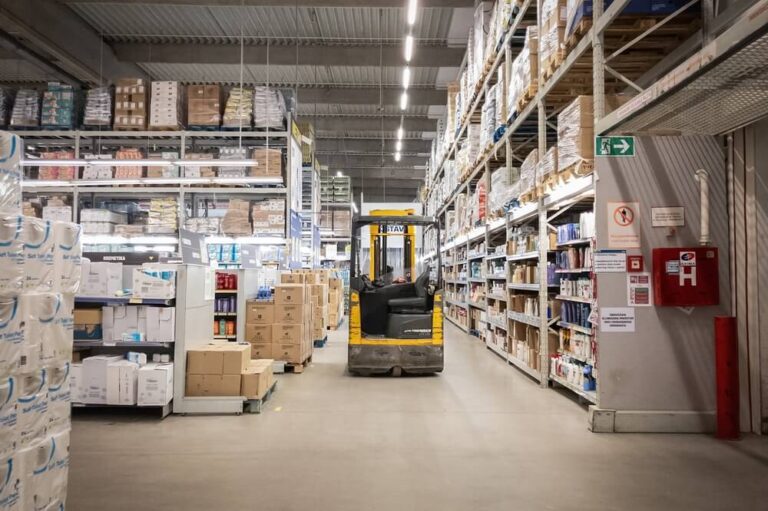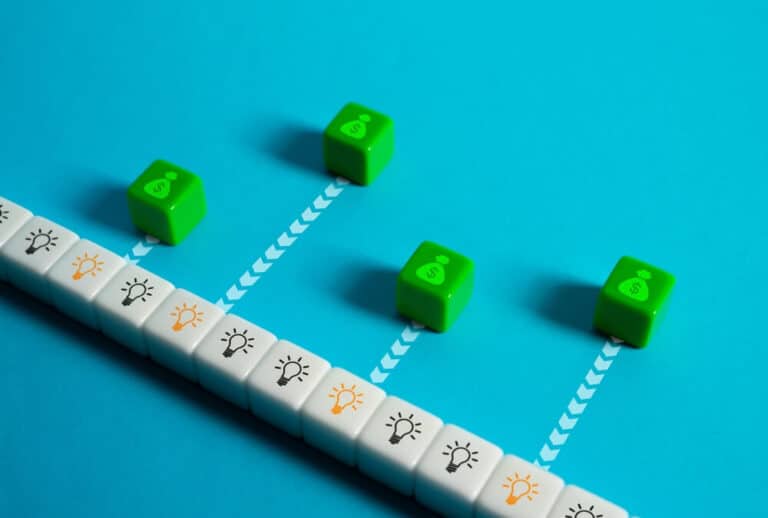Even the greatest, most successful products eventually decline.
Take Apple for example. The iPod was a massive success for years after its first release in 2001, yet it was discontinued in early 2022. The original Macintosh 128k sold 250,000 units in its first year in 1984, yet they’re nothing more than ancient artifacts and collectors items today.
What separates the best companies in the world from the one-hit-wonders is this:
Constant innovation.
Even when you create a massively successful product, sitting back and settling with your past success is a one-way ticket to business decline.
As the iPod began to fall off, Apple didn’t simply sit around with its fingers crossed, hoping it would rebound—it was already well into developing new, innovative products like the iPhone and iPad.
Consistent success comes through consistent innovation and product development. If you have a successful product in your catalog, why wait for it to fall off before exploring new or connected product lines that can extend your hero product’s shelf life and future-proof your catalog?
The best product teams and entrepreneurs are experts at what’s called product life cycle management—understanding where current products fall within their life cycle and constantly diversifying the catalog around them.
In this guide, we’ll explore the full product life cycle—from development to the maturity phase into the decline phase, and cover the advantages of why working with product life cycles in mind can help you succeed.
Table of Contents
What is the product life cycle?
The Product Life Cycle defines the stages a product moves through during its lifetime. There are typically four commonly accepted product life cycle stages—introduction, growth, maturity, and decline.
At Gembah, we’re firm believers in a fifth stage—development.
Before introducing your product to the market, you must focus heavily on development as your primary stage. If you get the development phase wrong, your product may never live to see the growth stage.
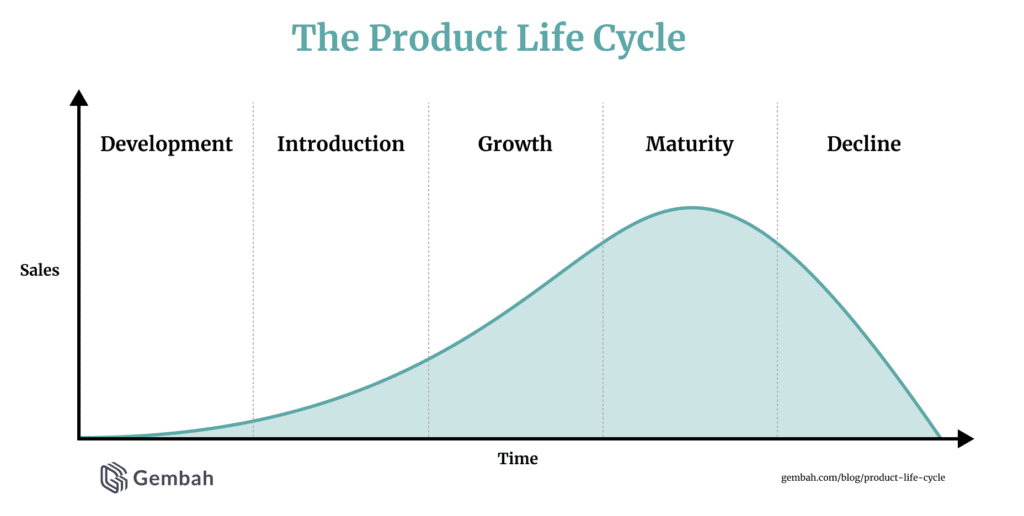
Why are the product life cycle stages important?
Following the life cycles of your products is essential in running a successful, future-proofed business.
If you have a solid understanding of where your top-performing products currently sit within their life cycle, you’ll be much more well-equipped to prioritize growth, marketing efforts, or net-new product development—depending on where your attention should lie.
You can aggregate customer and sales data to ensure you know where you are in the product life cycle and learn how to predict each phase before it starts. Many external factors will likely affect your product’s life cycle, including economic policies, socioeconomic conditions, and consumer sentiment. However, you should strive to ensure one constant—the development stage of the product life cycle.
Development isn’t just stage one—it will be an inherent part of every moment of your product’s life cycle. You’ll be in a constant state of product development, consistently improving or adding new products to your catalog—just like some of the biggest and best companies in the world.
At Gembah, we’re world leaders in product development processes, helping SMBs explore affordable development ideas, teaching the value of this ongoing cycle, and ensuring you can repeat the process as often as needed.
Why should product development be an ongoing process?
So you launched a successful product. The orders have been flowing for months, and it’s clear you’ve found something with a sizeable audience willing to pay.
First of all, congrats!
Now you might be thinking, “Our product has absolutely taken off, the sales are coming in fast—why would we fix something that isn’t broken? The product is solid and it’s not going anywhere.”
The reality is, every product has a life cycle, even if it seems like yours will last forever right now.
We don’t want you relying on a single product to ensure your company’s success or getting complacent when one product starts to pay off.
Continuously developing and launching new product lines is key if you want to build upon the momentum you’re seeing today and grow the value of your business—whether it be to set up a potential exit or to maintain a lifestyle business.
The main goal of ongoing product development is to constantly level up your company and diversify your revenue sources.
What if a competitor launches a lookalike product tomorrow with a 10x larger marketing budget to promote it?
What if your product becomes obsolete sooner than you expected because of, say, a global pandemic drastically shifting the economic climate?
When product development is ongoing, you’re mitigating the risks within your product catalog. This isn’t to say that a competitor launching a lookalike and stealing market share would be fine and dandy—it’s that this one lookalike product wouldn’t be able to completely sink the value of your entire business overnight.
What are the stages of the product life cycle?
We’ve briefly touched on the different stages in a product’s life cycle above, but what does each stage truly represent, and why do we believe development deserves a dedicated spot on the list?
Let’s explore.
1. Development stage
Every business’s product development process might be slightly different, but it’s an essential part of turning a concept into a commercialized item that people actually want to buy.
Basic product development moves through phases as well, including:
- Identifying the Idea
- Researching & Evaluating the Initial Idea
- Developing Design Criteria
- Creating a Prototype
- Manufacturing a Limited Run to Test Sales
- Testing Economies of Scale
At Gembah, we believe one of the most important steps in the process is the research phase. We recommend a 4-part process for new product research:
- Opportunity assessment: How large is the potential market?
- Competitive analysis: Who’s competing in the market today?
- Profitability analysis: Is the product viable from a business perspective?
- Target market research: What do potential customers think of what exists today?
From there, you’ll be well-equipped to move into the prototyping and testing stages, armed with confidence in the market size, your ability to win, and what potential customers are looking for in a product.
As your product begins to drive sales, you should still be innovating and evaluating. Constantly look for new ways to enhance the product, streamline production, reduce your costs of goods sold, find new channels for distribution, and more.
Why is the product development stage so important?
Product development is critical because it helps you assess risk and mitigate failure.
How well you understand your product, industry, and the current market can all affect your success and change how you approach your product sales and marketing. Many SMBs tend to overlook product development, and the result is that they don’t meet the minimum requirements for success which include:
- Providing value to customers
- Solving a problem for your target market
- Growing your business with healthy profit margins
- Successful product launches rooted in research
Recommended Reading: A Guide to Prototype Product Development
2. Introduction Stage
It’s time to launch.
With your initial version of the product researched, developed, and tested, it enters the introduction stage. At this point, sales are likely low and slow to grow.
Your goals at the introduction stage are two-fold:
First, build product awareness to win market share and drive sales (of course), and second, collect as much customer feedback—direct and indirect—as possible to refine and improve your product.
Pro tip: Consider these two price-setting strategies to get you started in the introduction stage:
- Price Penetration: Enter the market with a lower price to capture market share before raising your prices as your customer base grows.
- Price Skimming: Charge a higher price first to establish value and exclusivity before lowering your price as your base grows.
3. Growth Stage
If your product is able to meet the needs of the market, you’ll move into the growth stage.
By now, your product is resonating with customers and demand is growing quickly. At this point, you’ll often see a take-off moment where sales begin to grow exponentially.
During the growth stage, you’ll also experience a rise in competition and market saturation. As your product catches on, others will notice and enter the market alongside you. With competition increasing, comparing your product to competitors may show you how to increase your market share and improve your product for a secondary or tertiary release.
4. Maturity Stage
With maturity usually comes a decline in sales and market growth.
The keyword here is growth, as you may not experience a decline in actual sales volume. Rather, the consistent growth you’d experience during the previous stage will slow. Sales may be flat month over month, even year over year for some.
You might see increased efforts in marketing strategies as competitors strive for their piece of the market share. Price undercutting, promotions, and social media campaigns begin in earnest, with each competitor striving to achieve a certain amount of customer and brand loyalty.
Once the maturity stage hits, it’s crucial to begin preparing for the decline and next cycle. In some cases, this may be where you explore v2’s of your hero product (think Sony is launching new PlayStation models as sales of older versions begin to slow).
Again, if you’re already operating in a constant state of product development and innovation, and constantly launching new products and product lines, reaching the maturity stage with some products will simply open the door for others to grow.
5. Decline Stage
While not entirely inevitable (see, Coca Cola), the decline stage does happen to most products.
Sales fall off and market share decreases.
Ideally your products avoid the market decline stage for as long as possible, but reaching this stage also does not signal an immediate fall off a cliff. Even with declines in sales and market share, strategic marketing and advertising techniques can prolong the lifespan of your product. For example, a business strategythat are like focusing on how you stack up against the alternatives can be successful at this stage since building product awareness is less of a focus than beating the alternatives.
You also may be able to try a few strategies to slow or reverse the decline, including:
- Reducing your marketing efforts to cut costs and harvest the product’s life for as long as possible. You might even redirect your marketing budget towards more research and the development of a better version of the product.
- Cutting down on low-performing distribution channels and geographic areas. You can slowly pull an underperforming product out of a specific market and gradually replace it with an upgraded version.
- Selling your product wholesale to niche retailers so you can dispose of the rest of your inventory and focus on the next product you’ve got lined up and ready to go.
Examples of product life cycle stages in action
Many examples of the product life cycle and its various stages are already available to explore. Let’s look at some wins and losses for various products and check out where they currently sit in their product life cycle and why.
The iPad
The iPad is an example of a new product and concept that isn’t so easy for others to copy. While products like personal digital assistants existed before the iPad and some new competitors, such as Android tablets, took some of their market share, the iPad has maintained its popularity for years.
Since its release in 2010, it took roughly two years to reach its maximum growth. And now, over a decade later, it’s still in the maturity stage.

How has the iPad achieved such longevity, and how long will it maintain the maturity stage of its life cycle?
The strength of the iPad and other Apple products is based on their branding and innovation. They started with the slogan “Does More, Costs Less” in 1993. Apple continuously revamped its brand in product developments and has reshaped itself into an exclusive, luxury brand with no cross-compatibility across other brand name products. Now, if you’re an Apple person, you have the iPad, the iPhone, the Apple Watch, and everything else in their product lineup — and you probably buy the updated version of each piece of tech every couple of years.
And that’s the core of Apple’s success. They innovate and renovate every single product in their lineup nearly every year. There are software updates, hardware changes, and new marketing campaigns to recharge interest in their products and maintain consumer satisfaction.
Livestrong Bands
While the iPad is a complex piece of technology tied to a luxury brand, the Livestrong rubber band from Nike is practically the opposite. Developed as part of a campaign to fund cancer research, the market took off immediately for this product. Why?
- You felt like you were doing good by contributing to cancer research
- It had a minimalist design you could wear with anything
- Nearly every celebrity wore one
- Initially had a very limited run and inherent exclusivity
However, the decline of this product’s life cycle was rapid compared to other products. It lasted a mere two years before tanking into the decline stage after a growth stage that only spanned nine months and had nearly no maturity period.
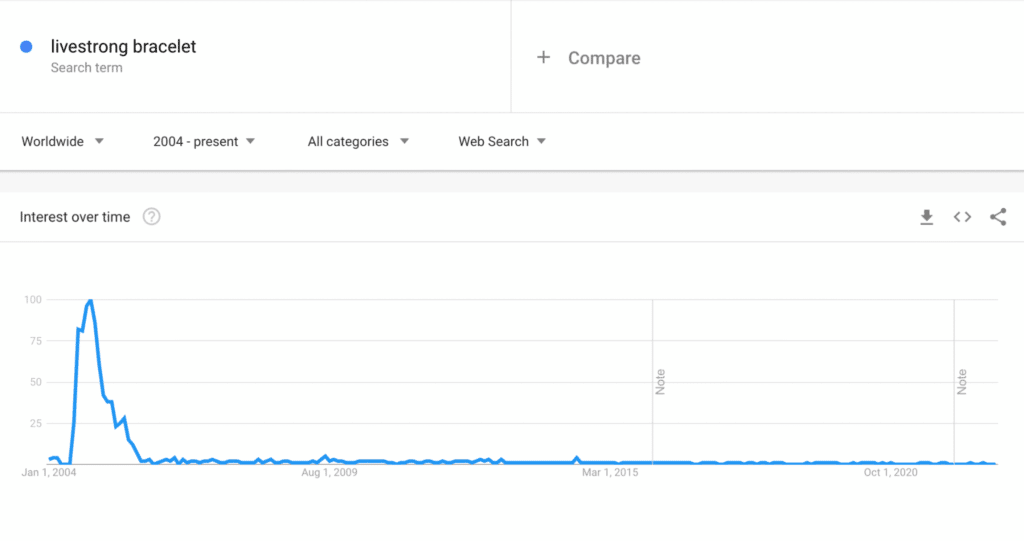
What went wrong?
A few things happened that caused the interest here to fizzle out. First, Nike didn’t maintain their “fight cancer” campaign for long. They also didn’t innovate the product itself. Yes, different colors, materials, and sizes came out, but at that point, the market was oversaturated with similar products, and competition pushed them out.
Blow Dryer Brushes
Blow dryer brushes have been on the rise since late 2020.
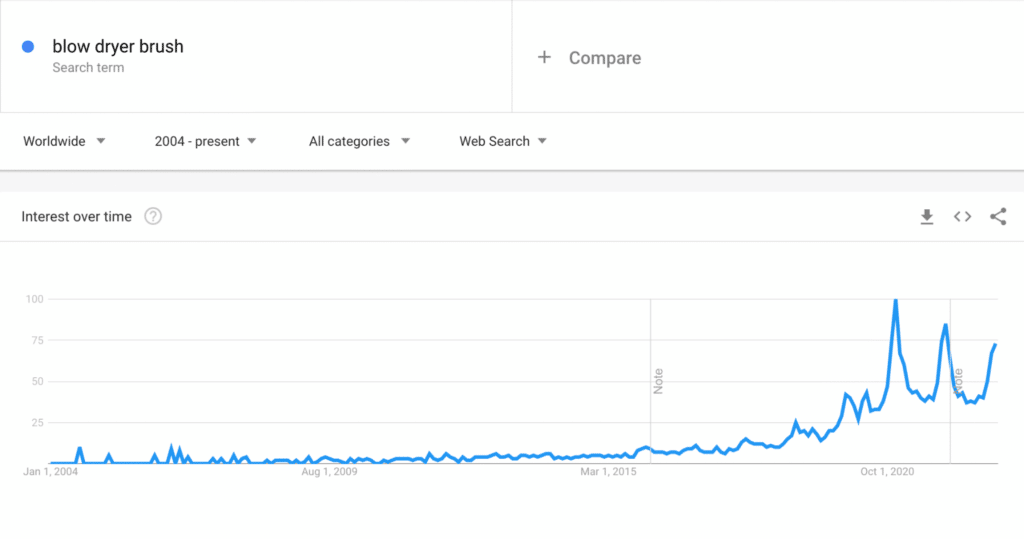
As it stands, this type of product is currently hovering between the introduction phase and growth phase. As such, there are still plenty of brands competing directly to become “the” blow dryer brush. This Cosmopolitan article covers 12 different brands, with names like Revlon, Dyson, and more all fighting for market share.
As is expected during the rise of a new product type, demand is high in the market and each competing product is likely iterating significantly today. Testing new distribution channels, ad copy and creative, marketing channels, etc.
Side note—not sure what a blow dryer brush even is?
It’s exactly what it sounds like. You may have seen them popping up on TikTok as well. From the same Cosmo article, here’s the Revlon version that they named the best overall hair-dryer brush:
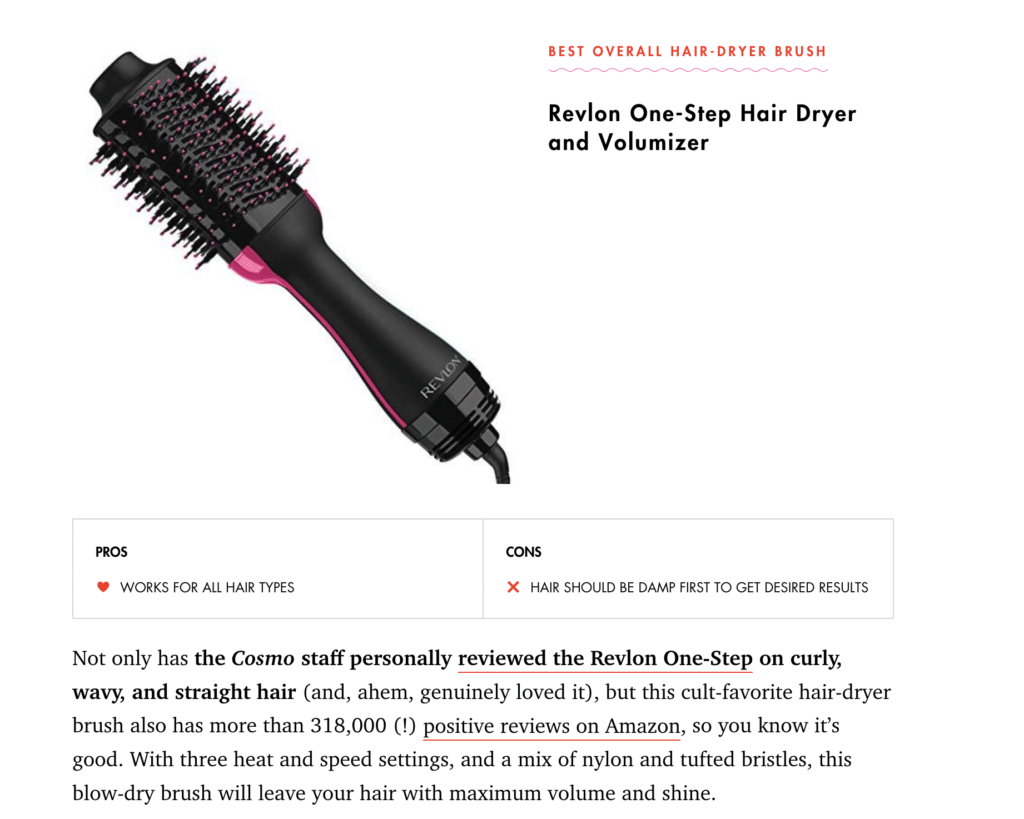
Product Life Cycle vs. BCG matrix
The product life cycle and the BCG matrix provide a lot of data about your products’ performance. They’re not mutually exclusive, and data from both can benefit your product redevelopment and overhaul over time.
What is the BCG matrix?
The BCG matrix operates through a four-celled matrix that includes Stars, Cash Cows, Question Marks, and Pets. Products are placed in each category based on their performance, which can help business owners determine where to push innovation, change budgets, or hold steady.
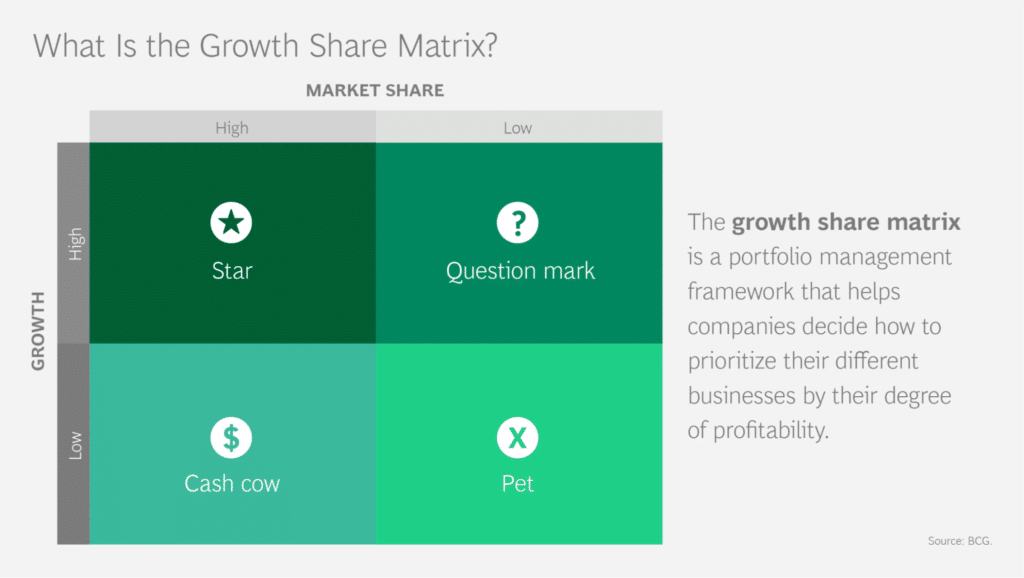
The four corners of the matrix are:
- Stars: Products that generate high sales but may also occupy a large portion of your budget. They’re usually within high-growth industries and have the potential to transform into Cash Cows.
- Cash Cows: The most profitable of products — reliably selling without too much fund reinvestment. They also are unlikely tocontinuegrowing beyond the market share they’ve already been able to earn.
- Question Marks: Products or brands that could go either way. They have a small foothold in the market but currently operate at a loss and could turn into Pets.
- Pets: Products that have essentially overstayed their welcome. Products in this quadrant are likely in decline, with sales and market share numbers decreasing.
Using the BCG matrix to make decisions that help your product life cycle
Analyzing your products’ sales and growth can help determine where they fit within the BCG matrix. Can you turn a Question Mark into a Star or Cash Cow with the right innovations and product rerelease? When do you know a product is done and dumped from inventory?
We recommend using both of these tools in tandem to guide your product development.
Advantages and limitations of the product life cycle
A product’s life cycle isn’t always steady and predictable, but using a product life cycle management tool could be helpful when tracking and analyzing new releases and older lines. Take a look at some pros and cons of using the life cycle method to manage your releases.
Pros of using the product life cycle:
- Helps you plan ahead
- Provides metrics for changing marketing strategies
- Ensures you identify and avoid pitfalls within each stage
- Can help compare your product to similar products during each stage
- Spot trends or mistakes more quickly and prepare for them accordingly
The only real “downside” to note would be the traditional product life cycle’s inability to account for every possible variable in a product’s life. For example, significant events like a global pandemic or recession can drastically alter certain markets and may shorten or extend a product’s life.
Because the product life cycle can’t predict everything, product managers shouldn’t follow the stage recommendations as if they’re written in stone. For example, your product might be seeing a dip in sales because of seasonality or other economic factors. Without further analysis, a product manager may see this dip as the beginning of the decline stage and pull the product line completely, creating a self-fulfilling prophecy that could have been avoided with closer examination.
So what does all this mean?
Innovation should always be at the core of your business.
The product life cycle is best used as a diversification system.
If too many of your product lines are in the maturity stage or nearing a decline, you risk rapid declines in sales that could potentially shut your lights off for good.
If too many products are still in the early stages of development and introduction, you may run into runway challenges due to low sales numbers. In this case, you may need to prioritize the research element to narrow your focus down to the best potential opportunities.
Ask yourself: What innovations could you be making that revitalize a product nearing a decline?
Perhaps there are hardware or software updates to the product itself. Maybe an entirely new version is warranted. The timing could be right to launch complementary products that help customers make better use of your hero products in their later stages.
At Gembah, we offer you the tools to do it all.
No matter what stage your product is currently in, we deliver an all-in-one platform that can act as your product development hub. Our platform has a workflow engine, product research engine, and expert database that can help you identify the optimal strategies for your team.
Sign up for Gembah today to see how we can improve your product development and release.


